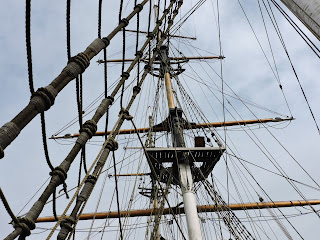This is a post which Eva wrote for our academic blog about our trip to Belfast. This blog contains the adventures of Brad, Meghann, Elizabeth, and Eva.
~~~~~~~~~~~~~~~~~~~~~~~~~~~~~~~~~~~~~~~~~~~~~~~~~~~~~~~~~~~~~~~~~~~~~~~~~
This past weekend we were in Northern Ireland. We spent a few nights on the coast of Downhill, a beach in front of the house and a cliff behind. It was beautiful. Our last day was spent in Belfast. We first heard a lecture from Brian, our bus driver. He shared his personal views and thoughts regarding the Troubles. After that, he drove us around Belfast. Noel joined us on the bus to tell us the other side of the story. It was very interesting to hear from both sides of the conflict, and it was uneasy to physically be in Belfast and feel the weight of sorrow in the city.
We made a few stops with Brian to a few memorials. What stirred feelings of sadness in my heart was the thought that each neighborhood has a handful of memorials dedicated to all the lives that were lost during the conflict from each section of the city. The first memorial had a phoenix rising out of the ashes. This image is powerful in that it tells of rebirth and sunlight. Perhaps the hope was to show that from the horror, peace would be brought forth and light would be shed upon the darkness of Belfast. Another memorial listed civilians who were killed- including six women by the crown forces and loyalist murder gangs.
After some time learning about the Troubles with Brian, a man of similar age came on the bus. His name was Noel, and he held a very different perspective of the Troubles. Noel has spent the last 13 years working on the communication between the two sides of the Troubles and developing tours for people to learn and further understand the issues. What led him to be so passionate about enhancing communication on either side of the wall was from his experience of being an ex-politically motivated prisoner. As we toured around Belfast with Noel, he pointed out how the houses were built by mill owners. These homes were built without any windows to protect against sudden bombs. The houses at the top of the street were Protestant-owned, and the houses at the bottom were Catholic-owned. Noel would tell us about the barricades that were created on either side. After years of conflict, bombings, and prisoners, there was a ceasefire in 1994. However, the tension did not settle then. A peace treaty was drawn up in 1998, but I can attest to the tension and sadness that still exists in Belfast today. When the peace treaty was created, the prisoners who served over 2/3 of their sentence were released. This included Noel and so he was released. From our time with Noel, I was overwhelmed by the unrest and hatred that seemed to exist. At one point, Noel showed us a field of yellow flowers and said how that once was a bonfire during the conflict. My heart ached, but the beauty of the flowers almost seemed to be redemptive of the peace that is slowly coming back to these people. A mural that we saw depicted children playing games in black and white. As we moved along the wall, the color was introduced, and the kids began to play games from this century. The cloth football became a rubber ball, and a game of stones became a kid with a music player. This mural was to educate viewers on the good outcomes of such hard times. One final story that I will share is when Noel took out the guitar and played a song about Billy. It turns out that Billy was a union volunteer fighter who saved his whole team by throwing his body on top of a bomb that went off early. The song was moving, and I was saddened to hear that he was not given a grave.
At the end of the day we were all exhausted, and personally, I was confused, sad and still had so many questions about the Troubles. To come to Ireland and not know much about the history, I have felt a huge sense of empathy for what happened here. I have seen how the history lectures lead up to what is happening today in Ireland and I appreciate that. Belfast was a really interesting day, filled with so much information. However, it was emotionally challenging as well. Other blog sites have held a lot of history that is fascinating and inspiring almost. Belfast held history that confused me and made me revisit the idea of God in all of this. How has God used the conflict in Northern Ireland to bring people together? Surely that is seen through the relationship between Brian and Noel, but where else has that happened? Still, so many questions to ask and more to learn.
































